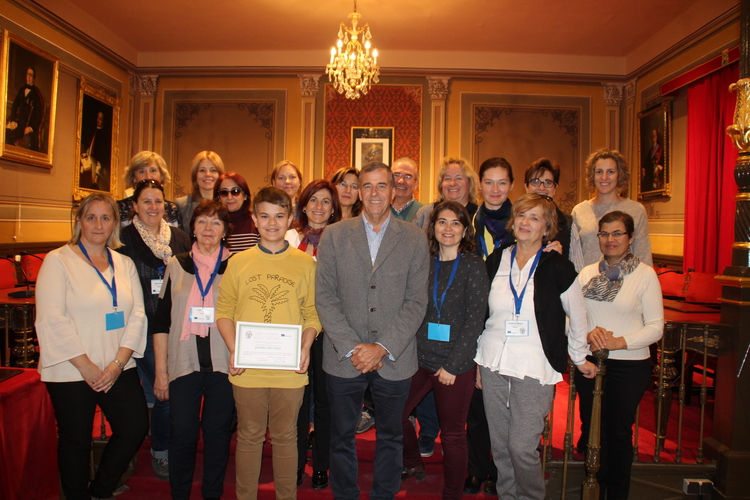El colegio Pedro I se creó en 1981 como centro de educación
infantil y primaria. Debido al crecimiento del número de alumnos/as se inauguró
un nuevo edificio el 24 de septiembre de 2010.
Durante el curso 2006/2007 se inicia la experiencia de
transformar nuestro colegio en Centro bilingüe en Francés desde la etapa de
Educación Infantil.
En el curso 2014-15 el centro pasó a tener un programa bilingüe
CILE 2; lo que supuso 8 horas lectivas de lengua francesa semanales.
Nuestro centro en la
actualidad es multicultural y conviven 14 nacionalidades diferentes (Marruecos,
Gambia, Mali, Ecuador, Bolivia, Guatemala, Venezuela, República Dominicana,
Argentina, Bulgaria, Rumanía, Polonia, China y Nicaragua), y una minoría de niñ@s de etnia gitana.
También hay en nuestras clases niñ@s con necesidades educativas
especiales importantes (parálisis cerebral, autismo…). Desde su inicio, la finalidad del programa bilingüe
español-francés ha sido fomentar en el
alumnado del centro el aprendizaje de la lengua y la cultura francesas desde un
enfoque comunicativo. Nuestro centro, por impartir también inglés, es plurilingüe.
El centro ha participado en distintos proyectos y programas
que están relacionados con la línea de trabajo prioritaria de nuestro Erasmus
Plus.
-
Commenius
2009-11: Developing the Global wordforce of the future: enchancing pupils life
skills and intercultural understanding through examining traditional stories,
sports and modern communication vehicles.
- -
Escuela promotora de salud desde el curso
2009/2010.
- -
Plan de convivencia.
- -
Escuela de creatividad.
- -
Proyecto de coro escolar.
- -
Colaboraciones con el CAREI
Nuestro nuevo reto es la convivencia para el enriquecimiento
mutuo mediante un Plan de Atención a la
Diversidad basado en una educación para la convivencia democrática, respeto a
los derechos humanos y a la diversidad de todo tipo (sexo, cultural, étnica,
social, intelectual…) y que posibilite el acercamiento cada vez mayor a la
igualdad de oportunidades.
Desde el centro llevamos a cabo una serie de actividades en el recreo, con las que se prentende
potenciar actitudes positivas entre iguales y que son relevantes para el
desarrollo de este proyecto:
- ·
Juntos somos mejores.
- ·
Bibliopatio.
- ·
Juegos cooperativos.
- ·
Zonificación del patio.
- ·
Maestro de apoyo.
- ·
Guardián de la paz.
Además, cualquier actividad a realizar en el Centro es
consultada a la Asamblea de delegados donde
los alumn@s aportan sus ideas y opiniones.
El trabajo
cooperativo y por proyectos se utiliza en el Centro como una metodología
que favorece la convivencia, el aprendizaje entre iguales y la autonomía
personal.
De suma importancia para el Pedro I son las salidas a entornos
próximos y lejanos como método para convivir y aprender de una forma
significativa; teniendo una amplia experiencia en la organización de
intecambios con otros países.
En el presente curso 2017/2018 contamos con un total de 21
unidades creadas: 6 infantil y 15 de primaria. En la actualidad al centro
asisten 491 alumn@s.
Pedro I school was created
in 1981 as a centre of infant and primary education. Due to the increase of
pupils a new building was inaugurated on September 24, 2010.
During the course (year) 2006/2007 it began the experience of transforming our
school into bilingual French Centre from the stage of Infant Education.
In the year 2014-15 the centre passed to have a bilingual program CILE 2; what
it supposed 8 school weekly hours of French language.
Nowadays, our centre is multicultural
and there coexist 14 different nationalities (Morocco, Gambia, Mali, Ecuador,
Bolivia, Guatemala, Venezuela, Dominican Republic, Argentina, Bulgaria,
Romania, Poland, China and Nicaragua), and a minority of gypsy etnia.
Also there are children with educational special important needs (cerebral
paralysis, autism …) in our classes.
From the beginning, the
purpose of the bilingual program Spanish – French has been promoting the
learning of the French language and the culture from a communicative approach.
Our centre, for giving also English, is plurilingüe.
The centre has taken part in different projects and programs that are related
to the priority line of work of our Erasmus Plus.
- Commenius 2009-11: Global Developing the wordforce of the future: enhancing pupils
life skills and intercultural understanding through examining traditional
stories, sports and modern communication vehicles.
· - School promoter of health from the course (year) 2009/2010.
· - Plan of conviviality.
· - School of creativity.
. - Project of school choir.
. - Collaborations with the CAREI
Our new challenge is the
conviviality for the mutual enrichment by means of a Plan of Attention to the
Diversity based on an education for the democratic conviviality, respect to the
human rights and to the diversity of all kinds (sex, cultural, ethnic, social,
intellectual …) and that makes the equality of opportunities nearer.
From the centre we carry
out a serie of activities in the playtime, with which it´s pretended to promote
positive attitudes between equal and that are relevant for the development of
this project:
· · Together we are
better
· · Bibliopatio
· · Cooperative games
· ·
Spaces´classification
· · Support´s teacher
· · Gardian of the
peace.
In addition, any
activity to realize in the Center is consulted to the delegates' Assembly where
alumn@s his(her,your) ideas and opinions contribute them..
The cooperative work and
for projects it´s used in the Center as a methodology that allows conviviality,
learning between equals and personal autonomy.
Really important for the
Pedro I are near and distant outings as a method to coexist and learn of a
significant way; having a wide experience in the organization of exchanges with
other countries.
In the school year 2017/2018, we
had 21 units at the school: 6 preschool units, 15 of elementary school. Nowadays, there are 491 students at the school.









































